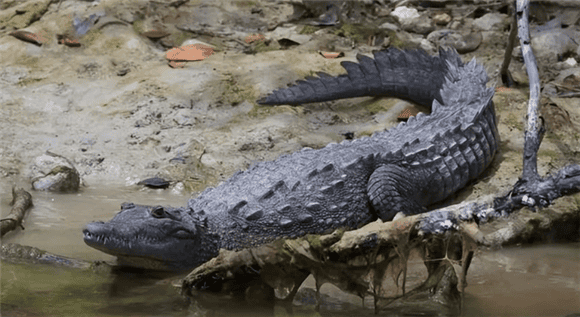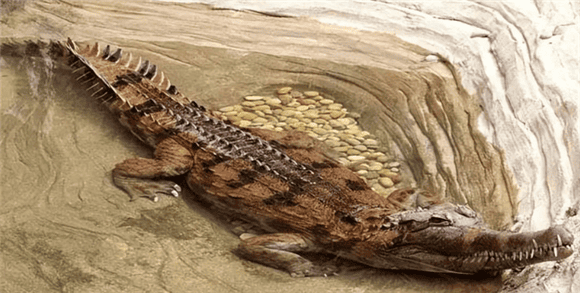One day, as I was browsing photos of wildlife, a stunning set of images caught my eye. These photos reveal one of the largest and most majestic creatures on Earth - the mammoth crocodile. I can't help but be attracted by these terrifying and mysterious creatures, and I am full of curiosity about what shocking characteristics they have. What made me even more excited, however, was that after further research, I realized that there were three particularly large crocodiles that shone with a mesmerizing light. Yes, it's the same crocodile, but they have completely different appearances and behaviors.
What is the size limit of a crocodile? Revealing the secret of the giant beast in the crocodile world
The crocodile is an ancient and mysterious creature on the earth. They are reptiles that usually live in rivers, lakes and swamps in tropical and subtropical areas. Although we often see crocodiles, many people still don't know how big their size limit is.
Let us first take a look at the largest known crocodile species - Gaelicsuchus. Gaelicsuchus is the largest of modern crocodiles and lives in freshwater lakes and rivers in Australia. According to research by scientists, Gaelic crocodile can weigh more than 1 ton and be more than 6 meters long. This huge crocodile is as amazing as a dinosaur. However, even the largest known crocodiles are far from reaching their size limit.
Scientists believe that the size of crocodiles is limited by the environment and food. In theory, if given enough food and a suitable living environment, the crocodile's size limit may be larger. However, considering the ecological balance in nature, the size of most crocodiles is usually between 3-5 meters. Crocodiles in this range are strong enough to easily prey on other animals and keep them alive and thriving.
In addition to Gaelicsuchus, there is another ancient giant beast-Stanleysuchus, which also deserves our attention. Stanleysuchus is the largest crocodile in the fossil record and lived during the late Cretaceous period about 90 million years ago. According to research, Stanley crocodiles can reach 12-14 meters in length and weigh 8-10 tons. This means Stanleysuchus was much larger than any currently known crocodile. However, the details of Stanleysuchus remain somewhat controversial due to the lack of a complete fossil record.
The size limit of crocodiles still needs further research and exploration. Scientists are working to find more fossil records to understand the ecology and evolution of ancient giants. At the same time, it is also necessary to strengthen the protection of modern crocodiles and protect their habitats and food chains to ensure that they can reproduce healthily and continue the species.
The 7-meter-long American crocodile is actually the largest crocodile on land?
In the animal world, crocodiles have always been one of the creatures that people pay great attention to. The American crocodile, in particular, is a reptile that lives in South and Central America. Its huge size has always been amazing. The American crocodile can reach 7 meters in length, making it the largest crocodile on land. This has aroused the curiosity and wonder of many people.
American crocodiles live in swamps, rivers and lakes in tropical and subtropical areas. They are strong and aggressive beasts with huge jaw strength and sharp teeth. American crocodiles are usually dark green in color, making them well camouflaged in water and among trees. They feed on fish, invertebrates and small mammals, often in ambush.
The American crocodile has become one of the main attractions in various nature reserves due to its huge size. When tourists watch American crocodiles, they can not only see their power and dominance, but also feel the mystery and magnificence of nature. While watching, be sure to keep a safe distance as American crocodiles are very aggressive.
Faced with the huge size of American crocodiles, many people will have a question: How did they grow like this?
The size and age of American crocodiles are directly proportional. Generally speaking, American crocodiles are only 30 to 40 centimeters long at birth, but their length continues to increase as they age. Adult male American crocodiles may grow up to 6 to 7 meters long, while females are smaller, usually only 3 to 4 meters long.
Food intake also plays a crucial role in the size of the American crocodile. They eat mainly meat and consume a lot of energy every day to maintain the operation of their bodies. Therefore, they need to consume large amounts of food to meet their needs. The abundance of food determines whether they can grow to huge sizes.
The living environment of the American crocodile also has a certain impact on the development of its body shape. They live in areas where water and land meet, which allows them to not only hunt in the water, but also eat animals on land. Because prey on land tends to be larger than in the water, American alligators can take in more nutrients that help their bodies grow.
It is precisely due to the combined effect of the above factors that the American crocodile can become the largest crocodile on land. Their huge and mighty bodies are not only stunning, but also highlight the wonder and magnificence of nature. By observing and learning about American crocodiles, we can have a deeper understanding of biological diversity and adaptability, and we can also cherish and protect our common home, the earth, more deeply.
The largest ocean crocodile: How did the saltwater crocodile become the overlord of the ocean?
Salt water crocodile, as the largest marine crocodile, is undoubtedly the overlord of the ocean. They live in the vast ocean and have strong adaptability and unique hunting skills, allowing them to occupy a top position in the marine ecosystem.
Salt water crocodiles possess outstanding size and strength. They can often grow to 6 to 7 meters long and weigh more than 1 ton, making them giants in the marine world. Their large jaws and sharp teeth allow them to easily capture and crush any prey they wish to eat. In addition, saltwater crocodiles also have thick limbs and strong muscles, allowing them to move freely in the water and quickly catch escaping prey.
Salt water crocodiles have unique adaptability. Compared to other crocodile species, saltwater crocodiles are better at adapting to saltwater environments. They have powerful kidneys and salt water excretion systems that can effectively handle excess salt in the body and maintain water balance in the body. This allows saltwater crocodiles to survive in marine environments and remain unaffected by changes in salinity. Saltwater crocodiles also have excellent concealment capabilities. Their skin appears gray or brown and blends in with the beaches and seafloor rocks in the ocean, making them difficult to detect.
Salt water crocodiles have powerful hunting skills. They are apex predators and hunt a wide range of fish, dolphins, turtles and other marine life. Saltwater crocodiles typically approach their prey silently and then attack quickly. They use their powerful bite force and sharp teeth to bite their prey in one bite, and then drag it into the water with great force, drowning the prey. Saltwater crocodiles prefer vulnerable prey, such as young dolphins or injured sharks, making them important in reproducing offspring and keeping the population in balance.

Salt water crocodiles also face some challenges. Due to human overfishing and environmental damage, the saltwater crocodile's habitat has been destroyed and its population is threatened. In addition, climate change has also led to rising sea levels and increased ocean temperatures, which have affected the living environment of saltwater crocodiles.
The largest freshwater crocodile: How did the Gibraltar crocodile adapt to the swamp environment?
The Gibraltar crocodile, also known as the African crocodile, is the largest freshwater crocodile in the world. They live in the vast swamps of Africa and have gradually adapted to this special environment through a long evolutionary process.
The size of the Gibraltar crocodile is key to their adaptation to the swamp environment. An adult Gibraltar crocodile can reach 6 to 7 meters in length and weigh more than 1 ton. Their large size allows them to move freely in swamps and prey on other animals with ease. In addition, the body of the Gibraltar crocodile is covered with strong scales, which can effectively protect itself from the outside world.
Gibraltar crocodiles have developed special organs and behaviors adapted to the swamp environment during their evolution. Their eyes are located at the top of their heads and allow them to see their surroundings underwater. This special eye position allows the Gibraltar crocodile to ambush its prey without being detected. In addition, they have sharp teeth and strong jaws that can quickly bite their prey and drag it into the water to drown.
The Gibraltar crocodile also has excellent swimming and diving abilities. Their body structure is designed to allow them to swim quickly through the water and chase fleeing prey. In addition, their tails are flat and muscular and can be whipped quickly to propel them forward. Such tails not only provide powerful propulsion but also help them maintain balance in the water.
A key factor in the adaptation of Gibraltar crocodiles to the swamp environment is their biology. They are cold-blooded animals that can adapt to different water temperatures and can rest underwater for long periods of time to reduce energy consumption. In addition, their stomachs are designed to swallow large pieces of food and store enough energy to cope with food shortages.
Although Gibraltar crocodiles have adapted to the swamp environment, they still face some threats. Human activities, water pollution and habitat destruction are reducing their living space. Protecting the Gibraltar crocodile and the swamp environment in which it lives is a shared responsibility.
What special physiological and behavioral adaptations do crocodiles have to living offline?
Crocodiles are one of the world's oldest reptiles, and they possess amazing physiological and behavioral adaptations that allow them to live in water and on land.

The body structure of crocodiles enables them to live underwater. Their bodies are streamlined to help reduce drag in the water and allow them to swim faster. In addition, crocodiles have a special respiratory system that allows them to stay underwater for long periods of time. They have lungs and breathing muscles that take in oxygen through their mouth and nostrils and then transfer it into the bloodstream. This adaptation allows crocodiles to lurk, feed and rest in the water.
Crocodiles also have special abilities to adapt to life on land. When they leave bodies of water and enter land, they face new challenges. Crocodiles have short, strong limbs that help them move on land and maintain balance. They have strong scales on the soles of their feet to prevent slipping and strong muscle control to move quickly on land. In addition, crocodile skin has a thick cuticle that prevents water from evaporating, keeps the body moist, and prevents excessive heat loss.
Crocodiles also have a unique behavioral adaptation mechanism. As cold-blooded animals, crocodiles rely on the temperature of their surroundings to regulate their body temperature. During cold seasons, they become immobile, lowering their metabolism to conserve energy. During the hot season, crocodiles use water bodies to regulate their body temperature, staying cool by swimming and soaking. In addition, crocodiles have a special adaptation mechanism for foraging behavior. They will lurk in the water, with only their eyes and nostrils exposed, and remain motionless, waiting for prey to approach. Once prey approaches, the crocodile will use its rapid speed and powerful jaw strength to capture it.
Only by working together can we ensure that these giant crocodiles continue to dominate the earth and provide us with their stunning majesty. Let us take action to save these creatures and leave more surprises and stories for the future. Looking forward to your comments and shouting for the protection of crocodiles!

 扫一扫微信交流
扫一扫微信交流
发布评论